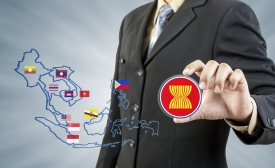asean
China and Southeast Asia are more intertwined than ever. Trade between these two regions is booming, and Chinese investors are pouring into Southeast Asia. China is fully involved in most regional security meetings organised by Asean. This era of Sino-Southeast Asian relations should therefore be a golden age bringing mutual peace and prosperity for all concerned.
China and at least two Asean members–the Philippines and Vietnam–remain locked in territorial disputes over the South China Sea. Beijing seeks to allay fears in Asean as it strengthens its economic and military clout in the region. One way to do this, an official said, is for the Chinese Ministry of Foreign Affairs to engage in what it calls “e-public diplomacy.”

CPD discussed ASEAN's impact on California featuring U.S. Ambassadors to Cambodia, Indonesia, Malaysia, and Singapore.
In East Asia a new kind of big country-small country relationship is taking shape. There are two big countries involved in this situation: a rising China and the long-established power that is the United States. These two big countries need to find a way of accommodating each other’s aspirations and managing current tensions or there could be a disruption of the existing relative peace in the region.
Protesters staged one of Vietnam's largest ever anti-China demonstrations on Sunday, decrying Beijing's deployment of a deep-water drilling rig in contested waters as territorial tensions soar. Some 1,000 people, from war veterans to students, waved banners saying "China don't steal our oil" and "Silence is cowardly" – a dig at Hanoi's handling of the dispute –and sang patriotic songs in a park opposite the Chinese embassy.
Japan and Myanmar on Sunday signed an investment treaty to nurture closer business ties as the once secluded Southeast Asian country opens its fast-growing economy to more foreign commerce. Prime Minister Shinzo Abe and Myanmar President Thein Sein signed the deal in summit talks following a gathering of leaders from the Association of Southeast Asian Nations in Tokyo.
Myanmar's president called Thursday for more investment and development assistance from the Philippines, saying his country needs help to catch up with the rest of Southeast Asia after emerging from nearly two decades of economic sanctions. President Thein Sein's visit represents a milestone in relations with the Philippines, one of the harshest critics of Myanmar's former ruling junta.
In the wake of the devastating Typhoon Haiyan, international aid is flowing to the Philippines. The United Nations released $25 million from an emergency fund and the United States pledged $20 million in immediate relief. But, for the moment at least, precious little assistance is coming from the region's behemoth. The Chinese authorities announced a paltry $100,000 in humanitarian aid (along with another $100,000 via the Red Cross Society of China).







